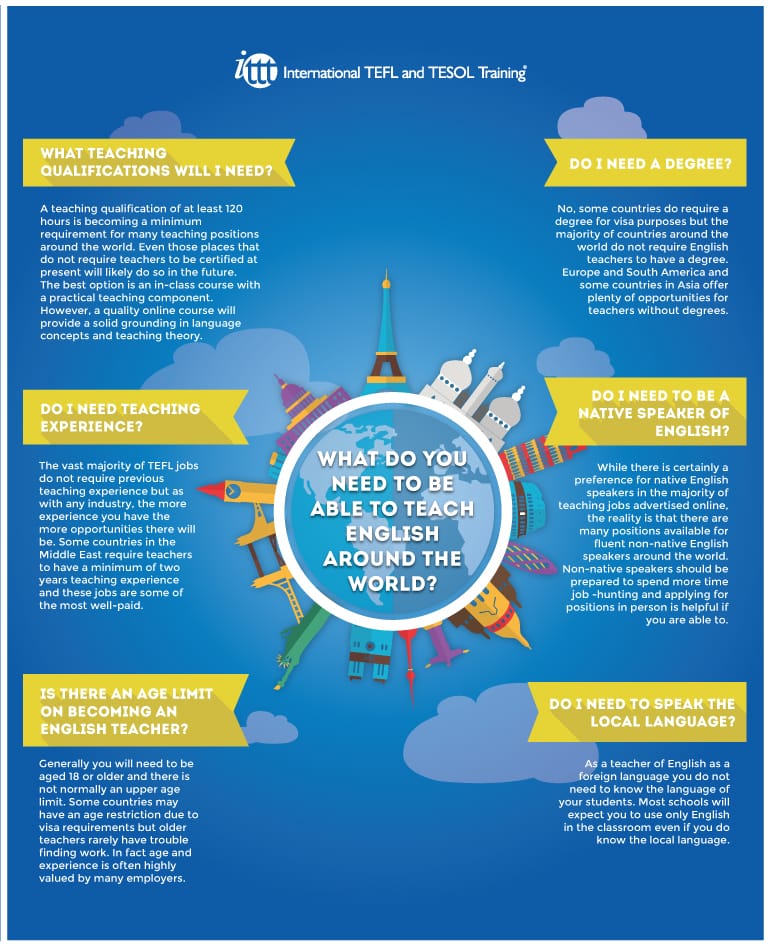TEFL vs TESOL
The Teaching of English:
The generally recognized acronym for the field of teaching English is ELT which simply means:
English Language Teaching.
Within this huge field there are a number of specialisms. One such specialism is the teaching of English to learners for whom English is not their first language. Three common acronyms that are often used when applied to this scenario are TEFL, TESL and TESOL.
- Are they the same?
- How are they different?
- Is one better than the other?
- Do employers have a preference?
- Which is more suitable in country X, Y or Z?
By defining the terms we will show that the idea of comparing one versus the other, i.e. “TEFL vs TESOL” is not particularly useful. So what do they mean?
TEFL: Teaching English as a Foreign Language
When the English teaching is to non native speakers and takes place in a country where the first language is not English. Examples would be teaching English in Peru or teaching English in Taiwan.
TESL: Teaching English as a Second Language
TESL applies when teaching English to non native speakers in a country where English is the first language. Examples would be teaching English to Vietnamese students in England or teaching non-native English-speaking immigrants English in New Zealand.
While both the above terms are often used to mean the same thing, the next acronym puts both these preceding terms into one definition:
TESOL: Teaching English to Speakers of Other Languages
This term describes the first and second situations as in both cases the learners’ first language is not English. Where it is taught is not important.
This analysis indicates that for the majority of the questions posed, the answer is that the two terms are used interchangeably throughout the industry. Having said that, it is also true that some countries are more familiar with one term than the other, examples being TESOL in the USA and TEFL in the UK.

ITTT courses and their qualifications
ITTT offers three routes to TEFL or TESOL certification. ITTT courses can be conducted entirely online, through onsite attendance at a training center, or via a combination of both.
ITTT Online TEFL/TESOL courses
A popular route to TEFL or TESOL certification is through online courses, with a number of options being available from ITTT, for new and experienced teachers alike. All ITTT online courses are internationally accredited.
- 1. They may be taken from anywhere providing you have a device and an internet connection.
- 2. There are many options for gaining an ITTT TEFL or TESOL certificate.
- 3. Online TEFL courses can be completed in a timeframe more suited to you.
- 4. At ITTT, we understand that some course participants may have a preference for the certificate they receive on successful completion. We therefore offer graduates the choice of a TEFL or TESOL certificate when they have finished the 120-hour or 170-hour course.
The ITTT online TEFL and TESOL course options include:
- 120-hour TEFL/TESOL certification course
- 170-hour TEFL/TESOL certification course with online specialization
- 220-hour Master Package
- 250-hour Diploma in TESOL
- 550-hour Expert Package
- 60-hour Specialized course in teaching English online
- 60-hour Specialized course in teaching English to young learners
- 60-hour Specialized course in teaching business English
ITTT In-class Courses
All in-class courses offered are taken over a 4-week period and result in a 120-hour TESOL certificate, with six-hours of observed teaching practice.
You can find details of the ITTT centers using the interactive map below.
For a description of what your course would involve see the graphic below.

Combined courses
These courses give you many of the benefits of online and in-class courses in a single package.
Due to the shorter in-class training time they are cheaper overall than in-class courses.
The ITTT Combined course is offered at the following locations.
- Bangkok, Thailand
- Barcelona, Spain
- New York City, USA
- Paris, France
- Phuket, Thailand
- Rome, Italy
The certificate you receive from completing the combined course is equivalent to the four-week course certificate and indicates six hours of observed teaching practice.

TEFL and TESOL jobs
To show how employers view the idea of TEFL vs TESOL we will look at a couple of current actual excerpts from job vacancies posted on our website.
1. Online position available.
Requirements: No degree or experience needed
Both non-natives and natives are welcome
TEFL/TESOL preferred
No minimum hours
Complete profile with video + photo (students choose teacher)
Professional attitude
2. School teaching position Thailand
Requirements: Minimum bachelor’s degree
TEFL/TESOL preferred
Motivated individuals who are dedicated to teaching and the betterment of their students
The requirements given here are generally typical and show that employers understand the equivalence of TEFL vs TESOL.
You can see this trend for yourself by taking a look at our jobs page here.
Using your TEFL or TESOL certificate to teach English
If you would like more information about teaching opportunities ITTT has created a country-by-country guide to living and teaching English in many countries around the world. The guides are a good introduction to life in each country; they also provide an insight into local customs.
More information here.
For an idea of the types of salary and living costs while teaching English, with your TEFL or TESOL qualification, have a look at our infographic below.

Lifestyle of a TEFL/TESOL teacher
For more on TEFL and TESOL teacher lifestyles you can review this infographic:




